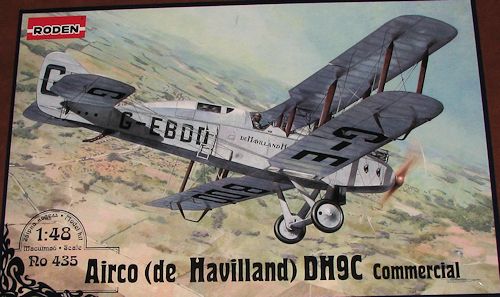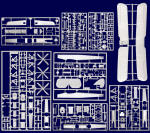
Roden 1/48 DH.9C Commercial
| KIT #: | 435 |
| PRICE: | $36.99 SRP |
| DECALS: | One option |
| REVIEWER: | Scott Van Aken |
| NOTES: |

| HISTORY |
| THE KIT |
 I
can see that Roden is going to be doing a full run of DH.9s in addition to their
extensive DH.4 line. It makes sense to do both types as so much of the airframe
is the same between the two aircraft. Though a rather simplistic way of stating
things, one only has to provide those specific bits germane to the type being
kitted.
I
can see that Roden is going to be doing a full run of DH.9s in addition to their
extensive DH.4 line. It makes sense to do both types as so much of the airframe
is the same between the two aircraft. Though a rather simplistic way of stating
things, one only has to provide those specific bits germane to the type being
kitted.
Well, Roden goes by the theory of 'include all the sprues that have the bits we need for this version' and that means a lot of spare parts. The civil version is a good one to kit as the type is interesting and appeals to those who like something a bit different.
Like other Roden WWI aircraft, this one includes a full engine and exhaust stystem. The fuselage is built of three major pieces. There is the side sections that also include the lower fuselage. The upper fuselage is a major difference from other DH.9s. This is the one that includes the enclosed section for two passengers. No in-flight service with this one, just a pair of wicker seats. There are actually four seats with another open seat right behind the very front one. Usually the pilot flew from the second seat, and that is where the control stick and rudder pedals are located. The instrument panel fits into the upper fuselage section. For the windscreen and passenger windows, an acetate sheet is included.
These aircraft have separate wing and interplane struts so keeping everything level will be paramount to having a proper build. I am sure many will devise a jig of some sort. The exterior boarding ladder is included as are separate control surface bellcranks and the lower wing skids. The instructions provide a complete rigging guide that includes control surface rigging. It will make for a very busy, but very cool looking model.
 Instructions
are well drawn with Vallejo paint references. This one is basically an overall
silver dope a operated by de Havilland Hire Service in 1922. The decal sheet is
well printed and typical of the day, contains very large registration letters.
Instructions
are well drawn with Vallejo paint references. This one is basically an overall
silver dope a operated by de Havilland Hire Service in 1922. The decal sheet is
well printed and typical of the day, contains very large registration letters.
| CONCLUSIONS |
I have to say that I like this one. It is a bit quirky and quite a nice difference from the usual warplanes. It will take some skill to build and rig, but the end result will be quite impressive.
| REFERENCES |
Roden web site
April 2013
Thanks to Squadron Products for the preview kit. Get yours today at your local shop or on-line retailer.
If you would like your product reviewed fairly and fairly quickly, please contact the editor or see other details in the Note to Contributors.